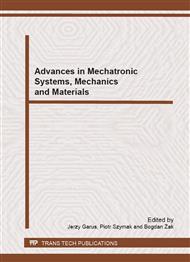p.20
p.28
p.43
p.51
p.62
p.74
p.82
p.88
p.95
Mechatronics Systems Supported by Vision Techniques
Abstract:
In the paper an application of vision methods and algorithms in various domains that contribute to mechatronics is presented. Regarding mechatronics devices and machines as robots, a vision system employed for a testing station simulating an industrial assembly line is discussed. Some numerical aspects concerning image pre-processing, analysis and geometrical transformations commonly used in robotics were introduced. To accomplish an effective investigation, the developed methodology and algorithms were implemented and verified on an experimental setup composed of two industrial robots and automation devices cooperating with two various vision systems. In the case of underwater robots for tank inspection, image pre-processing and analysis algorithms for the robot's position estimation, an image scale calculation and wall crack detection were investigated. An active vibration control system is treated as a mechatronic device which contains mechanical parts, electronics and software. In this example, a visual servoing architecture based on image features for controlling an active vibration control system was examined. For an effective investigation and synthesis of visual servoing algorithms, a MATLAB/Simulink/dSPACE hardware–software environment was employed. A vision system was used to analyze vibration amplitude of the vibro-isolation mass of the active suspension system and to provide a feedback control signal. The connection of 3D vision techniques with modal analysis was shown. Within the confines of the project a methodology for amplitude of vibration measurement and a software tool for modal analysis realization based on visual data were developed. The 3D measurements and structure of the construction were obtained by application and development of passive 3-D vision techniques. From this area, ‘structure from motion’ techniques were developed. In the experimental research, a mechatronic test stand was designed and manufactured enabling automatic two-axis control of a camera. A frame structure was built, in which a guiding-rail system was mounted enabling straight-line motion of a camera. Additionally, a system realizing rotational motion of a camera was built in. To control the experiment stand, software was created enabling the combination of the hardware-software part of the stand with the software part of a vision system. A tool was developed for the purpose of modal analysis and estimation of the quantities characterizing dynamic properties of the structure based on vision signals. As a conclusion, the presented, implemented and tested vision methods in various hardware-software programming platforms are discussed
Info:
Periodical:
Pages:
62-73
Citation:
Online since:
February 2013
Authors:
Price:
Сopyright:
© 2013 Trans Tech Publications Ltd. All Rights Reserved
Share:
Citation:


